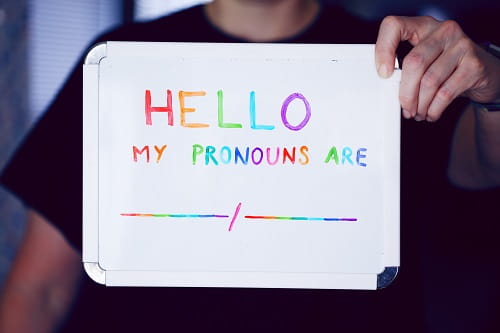What is Gender Identity?
Without trying to oversimplify, gender identity is a person’s inner knowing of their gender. Oftentimes people mistakenly interchange the words “sex” and “gender;” however, there is a strong distinction between the two:
- Sex: Refers to the how the physical body developed in utero. When people find out the developed sex of an infant, they can be quick to make assumptions about the child’s gender yet to develop.
- Gender: Refers to the multidimensional ways that people name and experience their gender. According to the American Academy of Pediatrics, “By age four, most children have a stable sense of their gender identity.”
Though gender identity is on a spectrum, and gender expression changes over time, children are aware of their inner worlds before society and family tells them who to be. We know this to be developmentally true. Metaphorically speaking, babies know to cry when they’re hungry and stop feeding when they’re full. When we apply that same autonomy and sovereignty to children and gender expression, it’s a lot easier to understand.
In fact, Dick F. Swaab, a Dutch physician, neurobiologist, and professor of neurobiology at the University of Amsterdam finds:
“As sexual differentiation of the genitals takes place in the first 2 months of pregnancy, and sexual differentiation of the brain starts during the second half of pregnancy, these two processes may be influenced independently of each other. . . Differences in brain structures and brain functions have been found that are related to sexual orientation and gender.”
Quite simply, the body develops before the brain. In other words, the brain structures that will form a person’s gender identity develop after the body. Because of this developmental timeline, it makes perfect sense that sex and gender could potentially not align as children grow into their identities.
While discussing gender identity, here are some common terms that are important to know:
- Gender expression: The outward, “public” expression of gender.
- Gender identity: The inner, deep understanding of gender. Sometimes expression may or may not align with gender identity depending on a person’s journey, community, and feelings of safety.
- Non-binary: A ranging term for people who are not solely feminine or masculine.
- Cisgender: A term for people whose sex at birth aligns with their gender identity.
- Transgender: A ranging term for people whose sex at birth does not match their gender identity.
- Agender: Someone who sees themselves as being gender neutral, not subscribing to having a gender, or not falling on the gender spectrum.
Visit Genderspectrum.org for high quality definitions and more information on gender.
Children are able to communicate their deepest selves when adults actually listen and refrain from imposing expectations upon them. Now that you have a foundation for understanding gender identity, use the following tips to discuss gender with children and to offer support for both the child and the parent(s).
Acceptance Starts with a Conversation
How to have meaningful conversations with children about gender identity.
- Come Prepared with an understanding of gender identity. (Pssst, if you read above, followed those resources, and did research of your own, you’re good to go!) For some, fostering safe, meaningful conversations can be challenging. Try to draft an outline, facts, or set of notes to help move the conversation in necessary ways.
- Offer Inclusive Resources. Children thrive when they see themselves represented in the media. From books to television and YouTube, when children have a positive role model to look up to, it helps them develop self-confidence and self-assurance. Following inclusive celebrities such as Jazz Jennings, Sherenté Mishitashin Harris, or the newest Cinderella’s fairy godmother, a.k.a Fab G, Billy Porter, can give children a sense of visibility and acceptance.
- Normalize. Accept and normalize gender identity and pronoun usage. Quite frankly, with thousands of years of collective history and over 7 billion people on this planet, as long as someone doesn’t harm someone else, something else, or themselves, anything is normal. No human should feel shame, embarrassment, or guilt for expressing and identifying their gender. However, it is important to be mindful of language when you’re normalizing. Read below for crucial info!
Acceptance Continues with Offering Support
How to support a child through discovering and expressing their gender.
- Be Mindful of Your Language. Part of coming prepared is being mindful of your language. Respect and use a child’s desired pronouns and name. When a child feels comfortable discussing gender or even disclosing their gender identity to you, greet them with love and acceptance. Some phrases can be secretly harmful like, “I love you no matter what,” because “no matter what” implies that something is wrong or damaging in the first place. However, as we discussed above, nothing is wrong.
- Educate Family and Friends. With consent, share the wealth of knowledge you’ve learned in order to make children more comfortable expressing themselves. (Yes, you can even send over this article.) If necessary, set boundaries with family and friends who don’t accept your child’s gender identity.
- Focus on Them. In the kindest way possible, don’t make it about you. Listen, validate, repeat what they say, ask how they would like to be supported, and follow through. If you mess up, apologize, educate yourself, and move on. Don’t dwell on your mistake. This is also not your turn to share any difficult feelings or opinions. This is your turn to show love and support.
Acceptance Means the Most from the Family
How to support yourself and/or your partner when navigating gender identity with your child.
- Stay Connected. They’re still your child. Don’t close off pathways for connection if you don’t yet fully understand your child’s gender identity. Traditions are still traditions, annual ball games can still happen, and life goes on. Don’t miss important memories while you’re processing. Love and meet your child where they’re at.
- Build Community. Find people who understand. Join support groups with options available for pre-teens, teens, adults, and facilitators. Participate in events to grow your community.
- Stay Up To Date. Immerse yourself in current media and resources about gender identity in order to best benefit your child. Celebrate, reference, and normalize celebrities who are also gender activists. Above all, keep doing your best.
About the Author
 |
Kat St.Pierre (she/her) is a former 8th grade English teacher turned freelance content/copywriter. Passionate about being kind to others, the planet, and herself, she loves using her voice to amplify important conversations and educate with empathy. Contact her at copykatstpierre@gmail.com or www.katstpierre.com. |
The opinions expressed in Montessori Life are those of the authors and do not necessarily represent the position of AMS.


